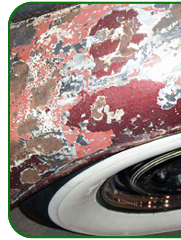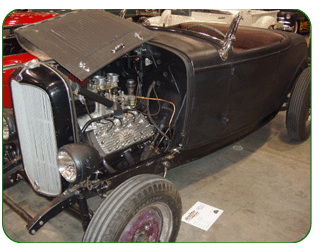|
I
|


 HOME
HOME
HISTORY
NSRA
HOT RODS
RAT RODS
EVENTS


|
I
|
|
|
|
|

RAT RODS:

Rat rod is a modern name for the original hot rod style of the early 1950's.
Many of the non-critical parts are often removed from rat rods, are usually finished in primer -like paints and are often period correct. Very often, rat rods are conglomerations of parts and pieces from several different cars of varying makes and models.
Although some may wear the term like a badge of honor, many rat rodders do not consider their cars rat rods. The term is considered derogatory to many traditional hot rod builders. New fans of hot rods, comparing yesterday's shiny hot rods to today's primed, lower and more radically designed hot rods, coined the term "rat rod" to describe these elemental cars.
An evolution of the jalopy, a dilapidated antique car that appears uncared for or neglected, the Rat Rod is based on the same idea. Bodywork is made to look dilapidated, or even completely derelict, whilst the underpinnings - engine, transmission and braking systems - are sometimes upgraded.
A typical rat rod is an early 1930s through 1950s coupe or roadster with the body set low on the frame. Remove fenders, add whitewall tires, big-little tire combos, expose the engine bay, install home-made upholstery, add lots of power ... and you have a rat rod!
A number of key aspects differentiate a rat rod from a hot rod. A rat rod is a home-built, low-budget, one-off custom vehicle that is frequently driven and has many superficial flaws and imperfections. "Bare to the bone..."
In popular usage, a hot rod is now defined as a high-end, high-budget show car that emulates the early hot rods in style...but sports flashy paint, high-quality upholstery and generally sees little in the way of road time. Classic and classy.
Some rat rods are built using the same parts and methods available to the early hot rodders of the late 1950's and 60's. Just as early hot rodders strived to build their own cars to the best of their ability, today's rat rodders also prefer to do so. Emphasis is on functionality, not flash.
Use of billet parts is frowned upon with original, vintage parts being preferred. Use of original, less common engines is also of choice. Rat rods are often powered by flatheads, straight sixes, straight fours and other relatively uncommon engines such as those made by Cadillac and Studebaker. The Oldsmobile Rocket 88 is a popular choice as well.
 Many of these cars appear unfinished with primer paint jobs being common. Other common rat rod finishes include patina (the original paint with rust and blemishes intact), a patchwork of original paint and primer, and bare metal with no finish at all in rusty or oiled varieties.
Many of these cars appear unfinished with primer paint jobs being common. Other common rat rod finishes include patina (the original paint with rust and blemishes intact), a patchwork of original paint and primer, and bare metal with no finish at all in rusty or oiled varieties.
Interiors will vary from fully finished to a spartan, bare bones form. A popular interior design made from Mexican blankets and bomber seats adds color and flair. Most are designed to be functional without many creature comforts, although this will vary with the owner's taste.
One main distinguishing characteristic of rat rods is that they are built to be driven. Many of these vehicles are used as daily drivers by their owners. Rat Rodders also enjoy showing off their pride and joy - while they are rarely trailered to an event, they are periodically trailered home.
All of them are built for fun...a vehicle that is cool and does not require constant care.
Although rat rods are often confused with traditional hot rods, today they have very little in common.
Rat rods have become popular with many enthusiasts as a reaction to the professionally built, billet encrusted, high dollar street rods at car shows. Many of these street rods cost upwards of $50,000 or more to build. Many are powered by a Chevrolet small block engine and automatic transmissions.
Some of these cars are trailered to car shows and only driven a short distance before being displayed. As one proud owner beamed “this car is meant for polishing, not driving!” The rat rod concept reverses this trend.
In many ways 'hot rod' is now synonymous with 'trailer queen' (a car that is never actually driven but exists purely for display and is trailered from show to show). Trailer queens are also sometimes called "custom cars" or "street rods". This, however, is one viewpoint among many.
At a car show, the prevailing connotations of the names are:
- HOT ROD - nasty loud and obnoxious
- STREET ROD - trailer queen
- RAT ROD - unfinished or in-progress hot rod or beater
- LEADSLED - kruise with loads of greezy character. Low and slow is the name of the game here. A shoestring budget is what leads to many rat rods appearing in coats of primer rather than paint...in the creative process one sometimes can not afford to build, paint and trim the rod at the same time. At one time, the rat rod or, even more so, the rat bike, was owned/built by an outsider for whom the machine was a statement of individuality and disregard for cultural norms.
Now, the rat rod is a statement of lifestyle. Tattoos, surf, rockabilly and more recently psychobilly music, garage rock, punk, hardcore and pin-ups are just a few of its cultural touchstones.
The vehicles and the term "rat rod" connote inclusiveness and pride of belonging. The term itself has been co-opted by business and is a marketing tool used to sell lifestyle items signifying membership in the subculture.
Items such as iron crosses, skulls, and the like are historically associated with hot rod culture by way of 1960s teen culture (see some of the "beach" movies of the period).
The December 1972 issue of Rod & Custom Magazine was dedicated to the 'beater', a low-budget alternative to the over-polished, slickly-painted, customized early car. The beater could easily be considered a progenitor of the rat rod.
However, owners of these beaters often had a high-dollar machine sitting in their garage: no expensive upholstery, primered if painted at all, no chromed and polished Corvette/Jaguar rear ends.
Like with many cultural terms, many dispute the origin of the term "rat rod."
Some say it first appeared in an article written in Hot Rod Magazine by Gray Baskerville about cars that still sported a coat of primer. Some claim that the first rat rod was owned by artist Robert Williams who had a '32 Ford roadster that was painted in primer.
It is well documented on the Hokey Ass Message Board HAMB that the first rat rods were built by the Low Flyers Hot Rod club in the UK in the 1980s. This pre-dates Robert Williams' claim that he built the first one.
|

|
|
|



 HOME
HOME






 HOME
HOME

